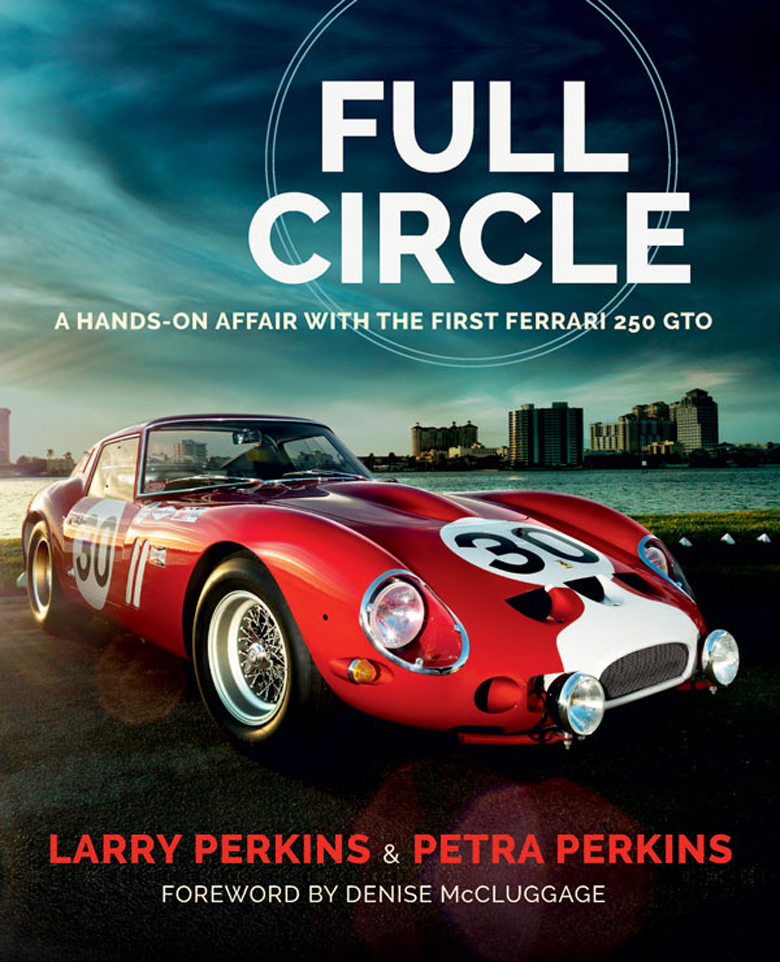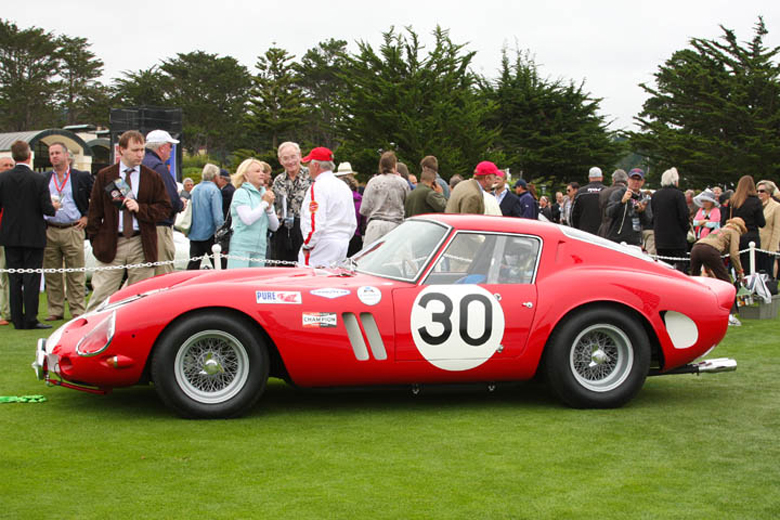Review by Pete Vack
Full Circle: A Hands-on Affair with the First Ferrari GTO
Hardbound, 228 pages, Foreword by Denise McCluggage
ISBN 978-0578-97104-9
US $45
Order here: www.FullCircleFerrariGTO.com
Larry and Petra Perkins are no ordinary couple. They met while both were working at an aerospace company and began to share a life of travel, sailing, cycling; they married in 1991. Then one day Petra overheard Larry talking about a Ferrari GTO he raced at Sebring in the 1960s. She had attended one race there, and hoped it would be her last. It was the year of the scary fire in the pits; earlier in the day she remembered watching a red number 82 car go round and round and so asked Larry if he was at that race. Larry was taken aback.
Yes! “It was 1964. I ran that race with Bill Eve, my co-driver,” he said incredulously. The GTO was number 82. The much remembered fire was that of the Sanesi Alfa GTZ that burned after being thumped by a Cobra. She had no idea her husband had been racing there and he had no idea she had attended the race. At the time, she was 14, he, 31. An amazing coincidence perhaps, but there was more. “I didn’t connect him with that era, that role, or with race cars at all. I know him as my sailboat mate, my lover, my bicycling partner, a rocket scientist, an exciting raconteur, and a visual artist. I didn’t know anything about any risk-taking race car driver, or even what a Ferrari is, much less a GTO.”
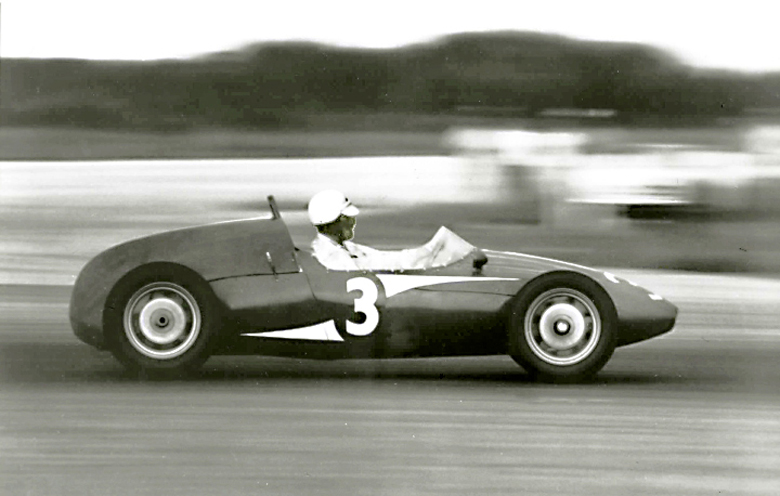
In the early 1960s Perkins began racing with a Fiat 600 and graduated to this Cooper BMC Formula Junior and he became serious about his racing.
Perkins owned and raced the GTO, s/n 3223, the first one built, from 1964 to 1967, giving it the rides of its life, always finishing well against more modern competition. But by 1969, after an interesting side career as a race driver, Perkins walked away from racing and cars to concentrate on his exciting career in the aerospace industry. He never mentioned his experiences driving race cars to Petra; it seemed so long ago and far away. It was not until 1994, when Larry tried his hand at sculpture, creating a work of art portraying Phil Hill behind the wheel, that he decided to go to Monterey, attending a FCA ‘Ferrari Year’ event to show his wares.
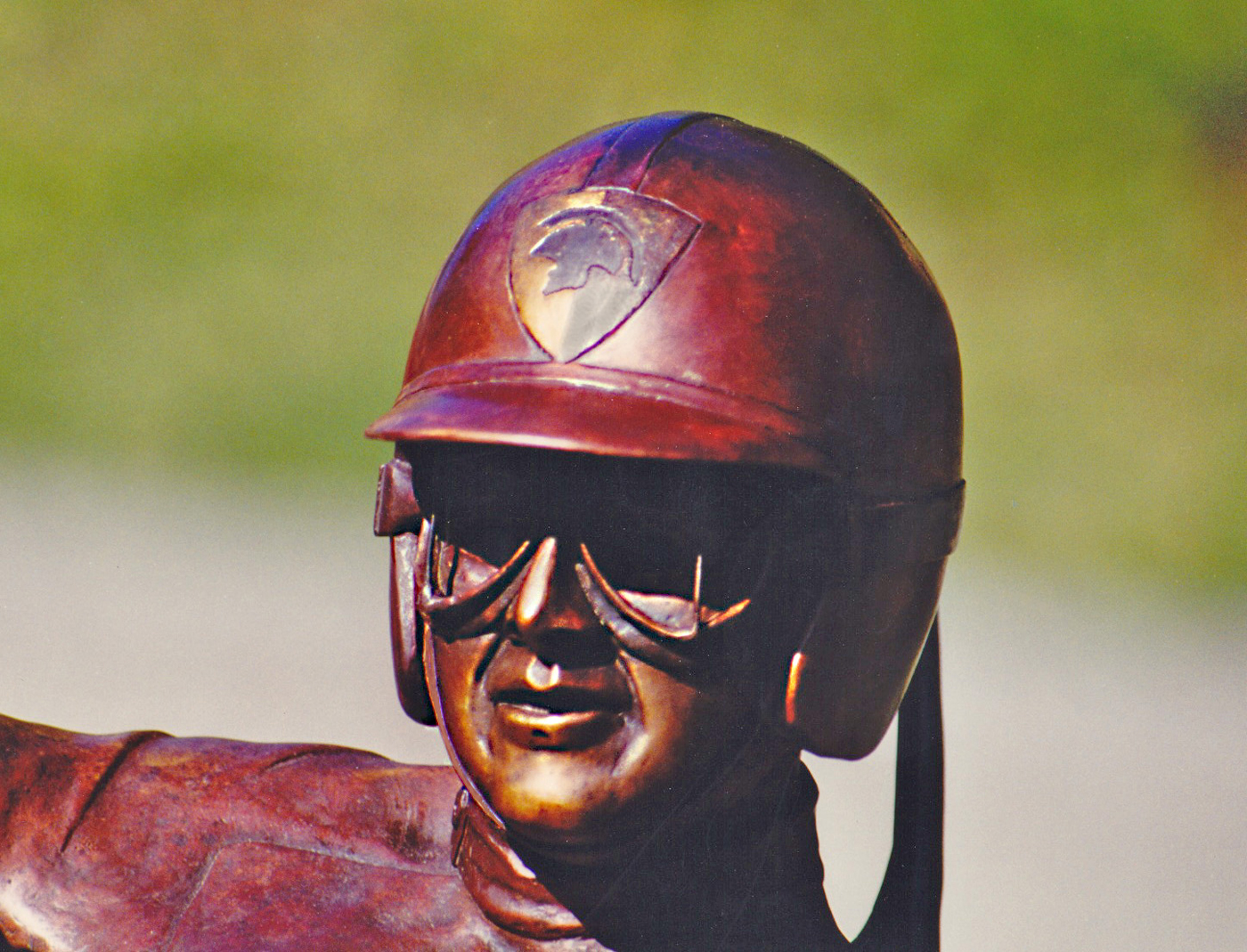
Many years later Larry tried his hand at bronze sculpture and created this bust of von Trips, who had given Perkins racing tips at Nassau.
Once again he would be with car guys; he had returned to the fold, as an artist rather than a driver. His previous life was about to be resurrected in a unique fashion. Ever the storyteller, Larry packed the GTO’s original ignition key and photos of the car in her racing days, “just in case.” Taking time to tour the car displays, Perkins saw what he thought might be his old car, his “Sophia” as he nicknamed her. He hadn’t seen it in twenty eight years, but felt that this indeed was his old GTO.
Had everyone been into serial numbers in 1964, verifying that this was the one might have been easy. But like most of us, Perkins never remembered or saved documents with serial numbers. So identifying the GTO as his took a different turn. The owner was approached. Larry began to remember unique things about the car, where they had moved the battery box, the cooling vents had been re-arranged, and the brake pedal modified. Still, when asked for the s/n Larry of course didn’t know. The owner was still skeptical.
Then Larry remembered he had brought the original GTO key with him.
He lost track of the car again, but seventeen years later, with a new owner, Perkins was again involved with Sophia, working with restoration expert Wayne Obry in Wisconsin. This time the GTO was restored to the 1966 Daytona 24 Hour livery, recalling the win in the Sport 3000 class and 19th overall driven by Perkins and Jack Slottag. It was entered in the amazing GTO class at Pebble Beach in 2011, and it did very well. The story of the Pebble Beach showing was ably told by the late Michael Lynch for VeloceToday in September of 2011.
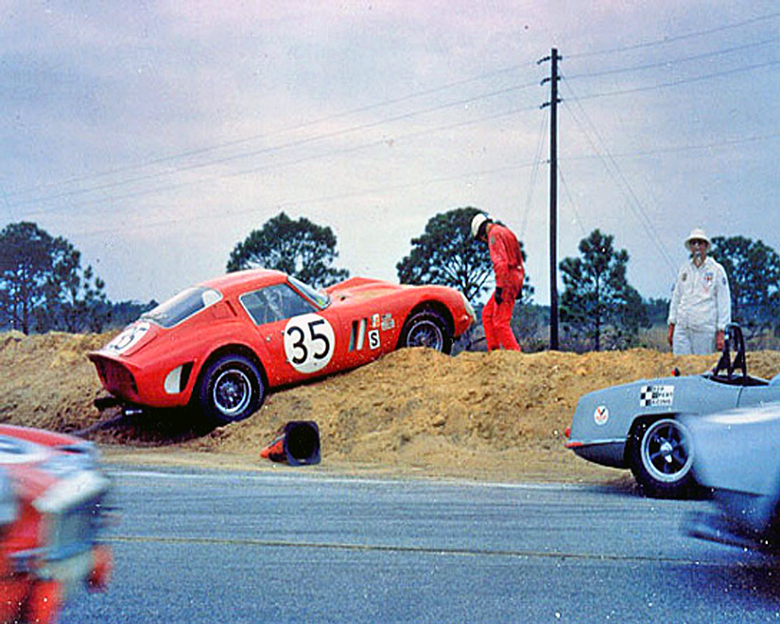
Sebring, 1966, and co driver Jack Slottag beaches the GTO on a sandbank. Their race was over, and it was an end of an era for Perkins.
In 2020, the team of Larry and Petra combined their talents to produce Full Circle, an autobiography of sorts. GTO 3223 serves as the centerpiece of the memoir, completing the circle from the purchase of the GTO to its restoration and showing at Pebble Beach in 2011. Petra, a widely published author who has won the Faulkner-Wisdom Gold Medal in Poetry was well suited to the job. In addition to adding her own perspective, the third person voice of Larry Perkins comes across as clearly as if he were sitting across from you at Bernard’s Surf bar in Cocoa Beach, Florida, where the story begins in October, 1963. Full Circle describes the years of success with the Ferrari, the teamwork, the victories and the agonizing sandbank ending of the 1966 Sebring, sponsorship, being jilted by Chinetti, and the final sale. Perkins credits everyone in his team in a special chapter, knowing full well that without the efforts of many, nothing would have happened. Not having access to parts, he relied on the genius of mechanic John Sabiston, who could fix and recreate almost anything. In a day long before in car cameras, Perkins skillfully writes one of the most vivid descriptions of what it’s like to drive a Ferrari GTO at full racing speeds at Daytona, on the banking.
An Addendum
But most of his life was devoted not to sailing or racing but being part of the most exciting adventures man has ever known, putting a man on the moon and the Viking Missions to Mars. Throughout the book there are references to Larry’s work with IBM, Martin Marietta, the various space programs in which he participated. It sounded very exciting, top secret, cutting edge. Yet Perkins does not get into details; how he went from a degree in Geology at LSU to a traveling soap salesman to a rocket scientist for IBM is left unsaid. This sounds a lot more serious and interesting than driving a GTO. So this reviewer, being naturally nosey, asked for the details.
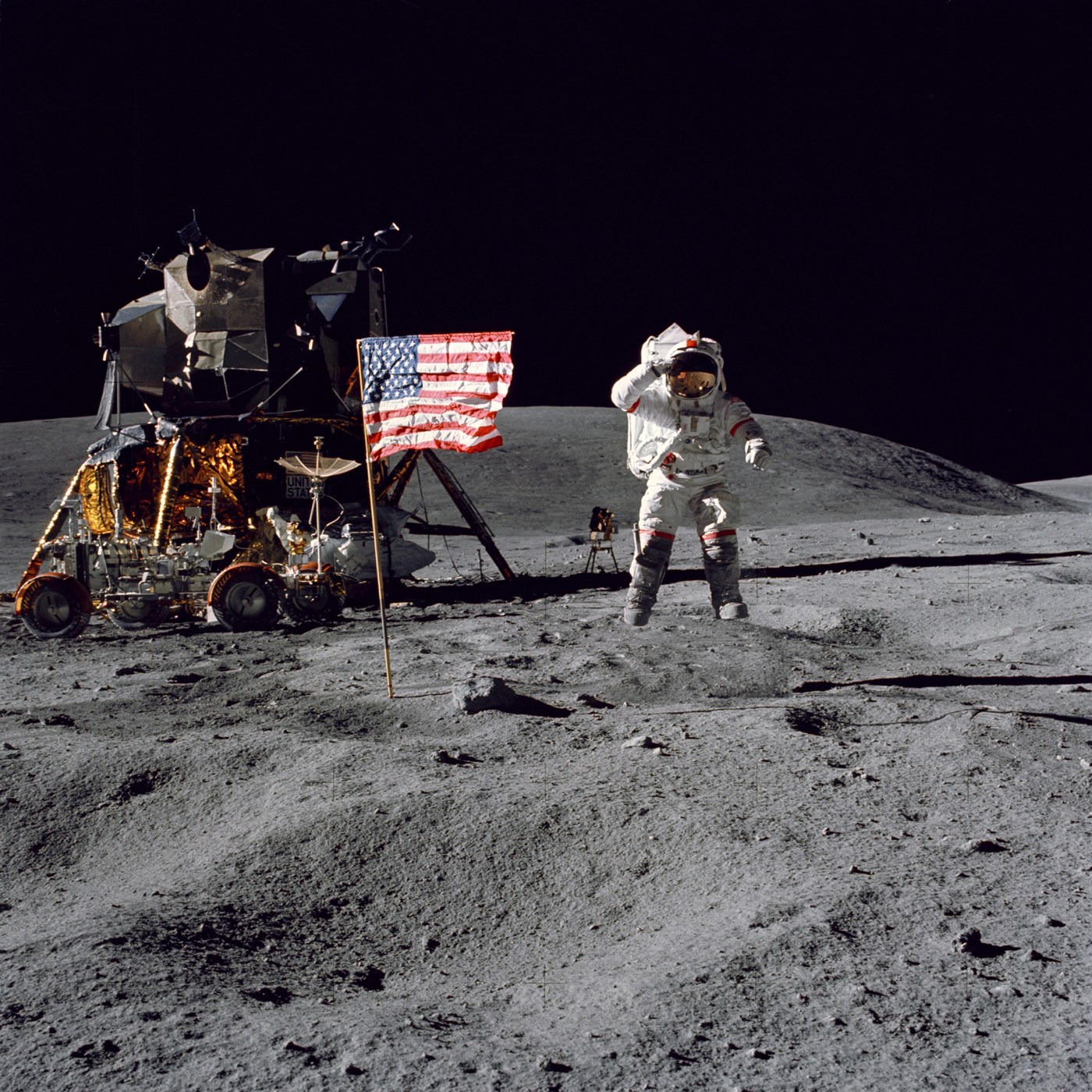
Perkins was a computer expert before there were such things, and with IBM helped get America to the moon. A remarkable and exciting career.
Perkins responded with a chapter entitled “Rocks to Rockets to Racing”, left out of the book but which told of his life as the aforementioned “rocket scientist,” a heavy job description, but yes, applicable in this context. We quote from this unpublished addendum, below.
After his stint with the Air Force and Colgate, he went to IBM, begging for something, anything that was more interesting than selling soap to supermarkets. IBM “thought my theoretical explorations in cybernetics at college, and my years of teaching and hands-on electronics experience in the USAF more than made up for any math deficiencies.” He lucked out, and was on his way to Cape Canaveral. Perkins continued:
“The next weeks, months, years in fact, were a whirlwind. Learning computer technology and programming OJT. (Computer schools and “computer science” as a discipline were still years away.) Learning how missiles and rockets worked. Visiting launch pads and blockhouses and instrumentation facilities, and closely observing about 150 launches a year.
“My first real assignment was to write a program for the IBM 1401 to prepare tracking data for further processing by the big IBM 7090. My mentor was a brilliant alcoholic Irish PhD named Patrick J. McCormick, and without Pat’s help, I’d still be trying to finish that program to this day!
“Over the ensuing eight years I worked on software for the real-time 7094 Impact Predictor and the near-real-time 1620 Weather Rawindsonde system. I wrote software to predict Saturn V launch overpressure envelopes, and programs to manage logistics for the down-range tracking ships. I worked on checkout software for the Titan III heavy-launch vehicle, and taught classes to personnel from all over the Cape. I moved on, leaving IBM for Martin Marietta. My next three decades or so were spent in similar pursuits on spacecraft programs and super-secret stuff, until at last I could say with some pride, ‘At the beginnin’ I coon’t even spell ‘rockit sign-tiss’ and now I are one.’”
Not to mention Larry also taught astronauts how to drive at the Florida SCCA driver’s school. Charles “Pete” Conrad, the third man on the moon, was a natural driver. Larry couldn’t believe it. “Well, Larry,” said Conrad, “after you’ve landed an armed jet fighter on a carrier at night, with no lights, in a pitching sea, driving a race car is a piece of cake.”
Sort of puts everything into perspective.
Larry Perkins raced a GTO when they were still hot, and during the day he worked with the NASA space program as it successfully landed astronauts on the moon. Not a bad way to spend the 1960s. A worthy read, a fascinating tale well told.
